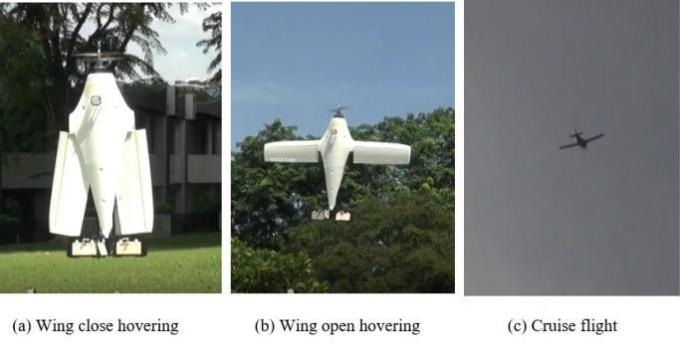Mar 28 2017
 Hybrid UAV U-Lion with three flying modes. (CREDIT - �Science China Press)
Hybrid UAV U-Lion with three flying modes. (CREDIT - �Science China Press)
A novel hybrid unmanned aerial vehicles (UAV), called U-Lion, has been built by two PhD students from the Unmanned System Research Group in National University of Singapore. They had spent four years creating U-Lion, which is designed to take-off and land vertically like helicopter UAVs, and transit to cruise flight like normal airplanes.
The wings can be fully expended or retracted to support the stability in VTOL mode or to deliver efficient lift in cruise flight. U-Lion can also fly autonomously, which includes cruise flight, vertical take-off and landing, and autonomous transitions. The new technology accelerates the application of hybrid UAVs.
The research details have been published in Science China Information Sciences, Volume 60, Issue 3, 2017. The research is chiefly performed by Wang Kangli, Ke Yijie under the supervision of Professor Chen.
For several years, hybrid UAVs have drawn global interest for their prospective applications in civilian and military operations, specifically in areas where there are severe constraints in their operating environment, for instance, forest mapping or sea surveillance.
The VTOL capability reduces the dependency of the take-off and landing amenities and cruise flying capability facilitates hybrid UAVs to perform duration and long range tasks. The hybrid UAV is a top research topic both academically as well as commercially. A number of companies have dedicated resources in designing hybrid UAVs, such as Google Project Wing.
However, because of the huge difference in the structure for fixed-wing UAVs and VTOL UAVs, it is an enormous challenge to integrate the two functionalities into a single UAV.
Former attempts to build hybrid UAVs only focused on either one of the flying modes, and never on both. Also, because of the high unpredictable aerodynamic forces in the transition process, the transition process is hard to automate.
To attain favorable performance in both flying modes, U-Lion is engineered in tail-sitter configurations with vectoring thrust and reconfigurable wings. U-Lion could implement various flying modes according to mission requirements, and regulate the wings to realize optimal performance.
The ability allows U-Lion to fly a lot longer than common VTOL UAVs and possess better maneuverability compared to standard fixed wing UAVs. Advanced modeling and control algorithm is also formulated for handling any uncertainties in transition and realize autonomous full envelope flight.
U-Lion, the autonomous hybrid UAV, has great potentials in many applications. The VTOL capability has widened its application environment and cruise capability enables it to performance long range tasks. The autonomous capability relieves the dependency of experience pilots and further expands its applications.
Wang Kangli, National University of Singapore
"Being optimal in both flying modes, U-Lion may bring a new way people operates drones. The fast reaction and static hovering capabilities bring U-Lion great potential in many applications, the VTOL capability allows it to operate in almost anywhere, including on vehicles on the sea." Said Ke Yijie, "In five to ten years' time, hybrid UAV will change the way people operate in areas like forest mapping, sea surveillance, power line inspection and disaster reaction. Being one of the best hybrid UAV, U-Lion will certainly lead the trend for future applications!"